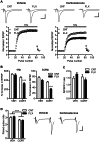Corticosterone facilitates fluoxetine-induced neuronal plasticity in the hippocampus
- PMID: 23675498
- PMCID: PMC3651130
- DOI: 10.1371/journal.pone.0063662
Corticosterone facilitates fluoxetine-induced neuronal plasticity in the hippocampus
Abstract
The hippocampal dentate gyrus has been implicated in a neuronal basis of antidepressant action. We have recently shown a distinct form of neuronal plasticity induced by the serotonergic antidepressant fluoxetine, that is, a reversal of maturation of the dentate granule cells in adult mice. This "dematuration" is induced in a large population of dentate neurons and maintained for at least one month after withdrawal of fluoxetine, suggesting long-lasting strong influence of dematuration on brain functioning. However, reliable induction of dematuration required doses of fluoxetine higher than suggested optimal doses for mice (10 to 18 mg/kg/day), which casts doubt on the clinical relevance of this effect. Since our previous studies were performed in naive mice, in the present study, we reexamined effects of fluoxetine using mice treated with chronic corticosterone that model neuroendocrine pathophysiology associated with depression. In corticosterone-treated mice, fluoxetine at 10 mg/kg/day downregulated expression of mature granule cell markers and attenuated strong frequency facilitation at the synapse formed by the granule cell axon mossy fiber, suggesting the induction of granule cell dematuration. In addition, fluoxetine caused marked enhancement of dopaminergic modulation at the mossy fiber synapse. In vehicle-treated mice, however, fluoxetine at this dose had no significant effects. The plasma level of fluoxetine was comparable to that in patients taking chronic fluoxetine, and corticosterone did not affect it. These results indicate that corticosterone facilitates fluoxetine-induced plastic changes in the dentate granule cells. Our finding may provide insight into neuronal mechanisms underlying enhanced responsiveness to antidepressant medication in certain pathological conditions.
Conflict of interest statement
Figures




Similar articles
-
Behavioral destabilization induced by the selective serotonin reuptake inhibitor fluoxetine.Mol Brain. 2011 Mar 16;4:12. doi: 10.1186/1756-6606-4-12. Mol Brain. 2011. PMID: 21410937 Free PMC article.
-
Fluoxetine induces input-specific hippocampal dendritic spine remodeling along the septotemporal axis in adulthood and middle age.Hippocampus. 2015 Nov;25(11):1429-46. doi: 10.1002/hipo.22464. Epub 2015 May 2. Hippocampus. 2015. PMID: 25850664 Free PMC article.
-
Chronic fluoxetine selectively upregulates dopamine D₁-like receptors in the hippocampus.Neuropsychopharmacology. 2012 May;37(6):1500-8. doi: 10.1038/npp.2011.335. Epub 2012 Jan 25. Neuropsychopharmacology. 2012. PMID: 22278095 Free PMC article.
-
Depression and adult neurogenesis: Positive effects of the antidepressant fluoxetine and of physical exercise.Brain Res Bull. 2018 Oct;143:181-193. doi: 10.1016/j.brainresbull.2018.09.002. Epub 2018 Sep 17. Brain Res Bull. 2018. PMID: 30236533 Review.
-
Neuroplasticity and behavioral effects of fluoxetine after experimental stroke.Restor Neurol Neurosci. 2017;35(5):457-468. doi: 10.3233/RNN-170725. Restor Neurol Neurosci. 2017. PMID: 28854520 Review.
Cited by
-
Neuroanatomical, Biochemical, and Functional Modifications in Brain Induced by Treatment with Antidepressants.Mol Neurobiol. 2022 Jun;59(6):3564-3584. doi: 10.1007/s12035-022-02780-z. Epub 2022 Mar 29. Mol Neurobiol. 2022. PMID: 35352302 Review.
-
Corticosterone exposure augments sensitivity to the behavioral and neuroplastic effects of fluoxetine in C57BL/6 mice.Neurobiol Stress. 2016 Jan 11;3:34-42. doi: 10.1016/j.ynstr.2015.12.005. eCollection 2016 Jun. Neurobiol Stress. 2016. PMID: 26844246 Free PMC article.
-
Novel Psychopharmacological Herbs Relieve Behavioral Abnormalities and Hippocampal Dysfunctions in an Animal Model of Post-Traumatic Stress Disorder.Nutrients. 2023 Aug 31;15(17):3815. doi: 10.3390/nu15173815. Nutrients. 2023. PMID: 37686847 Free PMC article.
-
Role of the 5-HT4 receptor in chronic fluoxetine treatment-induced neurogenic activity and granule cell dematuration in the dentate gyrus.Mol Brain. 2015 May 15;8:29. doi: 10.1186/s13041-015-0120-3. Mol Brain. 2015. PMID: 25976618 Free PMC article.
-
Rapid and lasting enhancement of dopaminergic modulation at the hippocampal mossy fiber synapse by electroconvulsive treatment.J Neurophysiol. 2017 Jan 1;117(1):284-289. doi: 10.1152/jn.00740.2016. Epub 2016 Oct 26. J Neurophysiol. 2017. PMID: 27784811 Free PMC article.
References
Publication types
MeSH terms
Substances
LinkOut - more resources
Full Text Sources
Other Literature Sources

